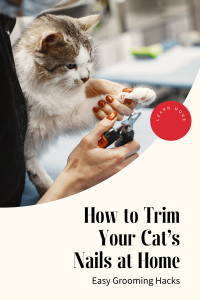How to Trim Your Cat’s Nails at Home

Paw-dicure at Home: A Gentle Guide to Trimming Your Cat’s Nails
Trimming your cat’s nails can seem like a daunting task, filled with visions of scratches and struggles. However, with the right approach, patience, and a little practice, it’s a vital grooming ritual that can be a stress-free experience for both you and your feline friend. Regular nail trims are essential for your cat’s health and well-being, preventing painful ingrown nails, reducing damage to furniture, and making playtime much safer for everyone involved.
Why Trim Your Cat’s Nails?
Unlike dogs, cats’ claws are retractable, but they still grow continuously. Without regular trimming, they can become too long, curving inward and potentially growing into their paw pads, causing pain, infection, and difficulty walking. Long nails can also snag on carpets or furniture, leading to painful tears or injuries. Beyond these health considerations, trimmed nails simply make living with your cat more comfortable for both of you, reducing accidental scratches during play or petting.
What You’ll Need: The Right Tools
Before you begin, gather your supplies:
- Cat-Specific Nail Clippers: There are various types, including scissor-style and guillotine-style. Choose the type you feel most comfortable with. Ensure they are sharp to make a clean cut.
- Styptic Powder (or cornstarch/flour): This is your safety net. In case you accidentally cut too deep and hit the “quick” (the sensitive part of the nail containing blood vessels and nerves), styptic powder will quickly stop the bleeding.
- Treats: Positive reinforcement is key! Have plenty of your cat’s favorite treats on hand.
- A Towel (optional): For wrapping a wriggly cat if needed.
- Good Lighting: Essential for clearly seeing the nail.
The Gentle Approach: Steps for Success
- Choose the Right Time: Select a moment when your cat is relaxed and calm, perhaps after a nap or during a quiet cuddling session. Avoid times when they are overly playful or stressed.
- Get Them Used to Paw Handling: If your cat isn’t accustomed to having their paws touched, start slow. Gently touch their paws, extending a toe and then releasing it, rewarding with treats and praise. Do this frequently until they are comfortable.
- Identify the Quick: Hold your cat’s paw gently and extend a claw by gently pressing on the top of the paw and the paw pad. You’ll see the translucent claw. Inside, there’s a pinkish area – this is the quick. You want to cut only the clear, pointed tip of the nail, avoiding the quick. For dark-nailed cats, the quick is harder to see, so err on the side of caution and only snip the very tip.
- The Snip: With your clippers, make a swift, clean cut just below the quick. If you’re unsure, it’s always better to cut too little than too much. You can always trim more later.
- One Nail at a Time (if necessary): Don’t feel pressured to do all 18 claws at once (remember, cats have five toes on each front paw and four on each back paw, with the dewclaw on the inner front paw). If your cat becomes agitated, stop, give them a treat, and try again later. Focus on getting one or two nails done per session if that’s all they can tolerate.
- Positive Reinforcement: After each successful trim (or even just trying), lavish your cat with praise and immediate treats. This creates a positive association with nail trimming.
- Address Any Accidents: If you accidentally cut the quick and it bleeds, don’t panic. Apply styptic powder or cornstarch/flour with gentle pressure until the bleeding stops. Reassure your cat and stop the session for the day.
Tips for a Smoother Experience:
- Start Young: Introduce nail trimming early in your cat’s life to acclimate them.
- Consistency is Key: Trim nails every 2-4 weeks, depending on your cat’s growth rate. Regular trims make the quick recede, making future trims easier.
- Wrap if Needed: For a very squirmy cat, gently wrap them in a towel (leaving one paw exposed at a time) for added security.
- Enlist Help: A second person can help hold and distract your cat with treats while you trim.
- Stay Calm: Cats pick up on your energy. If you’re stressed, they will be too.
- Know When to Call a Pro: If you’re truly uncomfortable or your cat is overly aggressive, don’t hesitate to ask your veterinarian or a professional groomer for assistance. They can often provide a demonstration or trim the nails for you.
With patience, positive reinforcement, and the right tools, trimming your cat’s nails at home can become a routine part of their care, contributing significantly to their overall health and comfort.

Leave a Reply